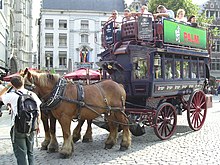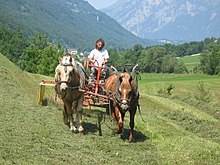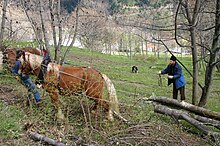Workhorse



A work horse or draft horse is the name given to domestic horses that are used to carry out work and that specialize in tensile loads .
history
The origin of the classic workhorse, the draft horse , is unclear; but one must assume that the foundations of the cold-blooded horse were not laid by successful breeding, but by natural adaptation before the horse was domesticated .
Modern cold blood breeding can now be found mainly in North America . These are all refined European cold-blooded breeds. Recently, however, attempts have been made in Europe to modernize the heavy, clumsy European lines by purchasing North American stallions . The Freiberg is traditionally bred in Switzerland .
By mechanization in the 20th century, many of the European draft horse breeds from extinction threatened; the agriculture has no need for them and the interest of individual lovers enough to preserve them barely.
But cold blood breeding seems to be breaking new ground. There is currently a trend towards the classic leisure horse, as a carriage and riding horse. For this purpose, a lighter, more common horse is bred as a breeding goal , which comes closer and closer to the heavy warmblood . This is to the chagrin of those who actually still work with horses or who start again, such as young farmers who are thinking about using the workhorse as an environmentally friendly and more natural variant of the tractor .
Nevertheless, these breeds have the advantage that the horse can be used both in agriculture and in leisure time .
Work areas
The tasks of workhorses include the use in agriculture to pull implements for tillage, to transport agricultural products and to operate stationary agricultural implements. A derogatory term for workhorses is field horse .
For a long time they were used as pit horses in mining . Shetland ponies in particular were used here.
Work horses are also used in trade for transport. The latter are nowadays, with a few exceptions, horses that are harnessed for advertising purposes, think of brewery teams.
They are also used as back horses when moving wood or clearing snow .
Covered wagon rides are offered more and more often and are currently an increasingly large area of work for draft horses, however, not only the original heavy cold-blooded horses can be used for this, but also breeds traditionally bred as carriage horses, especially heavy warm-blooded animals such as old Oldenburgs , Anglo-Normans , Cleveland Bay , Frisians or Saxon-Thuringian Heavy Warmblood .
In the early days of rail transport horses were in the 19th century often public transport as draft animals for horse tracks as iron or tram used to it before the 20th century by the steam engine or the electric tram railcars were displaced. Horse bus lines that existed in many cities have been replaced by motorized buses .
In the 19th century, canal horses carried barges with passengers or cargo on towpaths .
The term workhorse is used today in a figurative sense for robust machines and people.
military
literature
- Therese Grosswiele: Slower. Smaller. Well. With natural horse power from the progress trap in agriculture . Therese Grosswiele Verlag, Egling 2013, ISBN 9783000415487 .
- Michael Koch: Traditional work with horses in the field and forest , 4th edition. Eugen Ulmer Verlag, Stuttgart-Hohenheim 2012, ISBN 9783800177264 .
- Eva-Maria Amberger: Nothing worked without horses. Husbandry, use and customs of the rural workhorse around 1900 . Edition Güth in Landwirtschaftsverlag, Münster 2003, ISBN 3-7843-2789-3 .
- Jürgen and Uta-Marina Hagenkötter: When horsepower was still strong horses . Cadmos Verlag, Schwarzenbek 2009, ISBN 3-8612-7463-9 .



